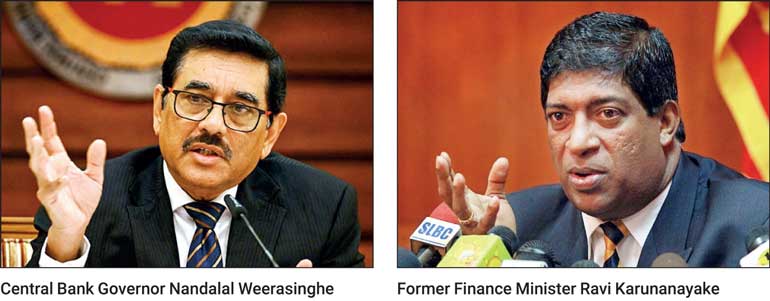Friday Nov 28, 2025
Friday Nov 28, 2025
Saturday, 29 July 2023 00:10 - - {{hitsCtrl.values.hits}}

The Government authorities are carrying out the domestic debt restructuring process or debt optimisation (Central Bank’s term) under a well-designed plan to attract the attention of creditors and if it fails to gain their consent then avoiding doing more harm than good might be very difficult, official sources claimed.
To ensure that it is done right the first time, sovereign domestic debt restructuring should be part of a broader policy package that effectively addresses the fundamental problems and debt vulnerabilities, it added.
Sri Lanka is persuading domestic creditors for a moratorium on debt repayments to manage Sri Lanka’s public debt rollover risks in the future as it has become essential to tackle the debt crisis.
At the recent investor presentation on Domestic Debt Optimisation (DDO) conducted on 7 July, the response of participants was positive but there was no indication for an agreement for the Government’s policy actions and a comprehensive debt treatment, official sources revealed.
To garner broad creditor participation in the restructuring and reduce the likelihood of costly litigation, the process of restructuring has to be perceived as fair and transparent.
International Monetary Fund (IMF) is likely to suggest some amendments to their Debt Sustainability Analysis (DSA) targets by considering the slow progress of achieving economic reform program commitments to ensure that the country restores the sustainability of its public debt.
In its first policy review in September, the IMF may direct Sri Lanka towards the second DDO strategy if the targets of the current plan are not achieved, official sources warned.
According to the Central Bank Governor Nandalal Weerasinghe, “If the country deviates from the current path, there could be another domestic debt optimisation as well as another default and bankruptcy.”
On the other hand the Government is facing the daunting tasks of reducing its debt stock to 95% in 2032 from 128% in 2022, bringing down of GFN target to 13% of GDP in 2027-32 from 34.6% in 2022 and reducing FX debt service target to 4.5% of GDP in 2027-32 from 9.4% in 2022.
Although it is branded as a double edged sword by opposition politicians and some economic experts, the need to manage Sri Lanka’s public debt rollover risks in the future has become essential to tackle the debt crisis, says former Finance Minister Ravi Karunanayake.
Restructuring domestic debt is a tool for the country facing fiscal and economic stress. And it should not drag into the second round of restructuring, he said adding that IMF is flexible to consider the Government’s situation and accommodate its proposals and explanations relating to implantation of economic reforms.
The Government has embarked on an ambitious and well-balanced fiscal consolidation path in accordance with the economic reform prescription of the IMF to restore Sri Lanka’s macroeconomic stability and debt sustainability, Karunanayake revealed.
On the other hand, domestic debt is often held mainly by domestic creditors who will suffer losses, he said, adding that this can add to the economic malaise that made the debt restructuring necessary in the first place.
This new path mitigates the economic impact on the poor and vulnerable, safeguards financial sector stability, and strengthens governance and growth potential by passing previous modern monetary system of injecting large volumes of money into the banking sector.
Karunanayake, who in 2019 effectively handled the $ 1.5 billion IMF bailout deal to boost foreign exchange reserves and avert a balance of payments problem, noted that the new economic by passing pathway will be a catalyst to generate additional international financial assistance.
The ambitious fiscal reforms implemented by the Government now directs public finances on a sustainable path, enabling it to bring down unnecessary expenditure positively impacting its debt trajectory, Karunanayake added.
Revenue-enhancement and expenditure-rationalisation measures have been taken by the Government to treat the chronic economic ailment under bypass surgery of finding alternative channels, methods, or services to fulfil economic needs or goals outside of traditional systems.
The determined fiscal reforms implemented by the Government now directs public finances on a sustainable path, enabling it to bring down unnecessary expenditure positively impacting its debt trajectory, he pointed out.
The need of the hour is to implement Sri Lanka’s external and domestic debt restructuring strategy for necessary relief, but is insufficient to meet all debt sustainability analysis (DSA) targets, former finance ministry secretary and now senior Presidential Economic Advisor Dr. R.H.S. Samaratunga claimed.
This has become a pressing issue as opposition political parties and some economic experts are openly highlighting ill effects of the domestic debt optimisation strategy becoming barrier against its implementation.
There are three key aspects to address in the debt restructuring process. Firstly, discussions are underway regarding the restructuring of official bilateral debts.
Secondly, there are ongoing discussions regarding the money borrowed through sovereign bonds in commercial markets. Thirdly, there is a focus on optimising domestic debt. The optimisation of domestic credit plays a significant role in this overall process, he revealed.
According to latest Finance Ministry data, Sri Lankan domestic debt¹ as at end-May 2023, by holders is consisting of T-Bonds holdings of Rs. 9,032 billion, T-Bills holdings Rs. 5,113 billion, SLDBs holdings of $ 885 equivalent to Rs. 274 billion.
Central Bank’s T-Bills holdings and Provisional Advances to the Government converted into longer-term T-Bonds (subject to relevant legislation being enacted).